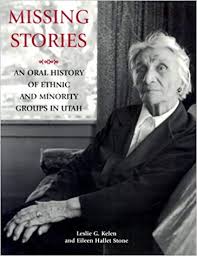Articles/Essays – Volume 31, No. 3
A Part of History Overlooked | Leslie G. Kelen and Eileen Hallet Stone, Missing Stories: An Oral History of Ethnic and Minority Groups in Utah
How do non-Mormons feel about living in Utah? Missing Stories answers many such questions. These are the people’s words and not interpretation. As Helen Papanikolas explains in the introduction, “This is not a book of scholarly history. It is a book of voices, voices of speakers who desperately want us to know how life was for them and their forbears in Utah” (1).
In 1982 the Oral History Institute received a small Utah Humanities Council grant to conduct interviews. From a modest beginning, the project grew to 729 interviews, including photographs, with Utes, African Ameri cans, Jews, Chinese, Italians, Japanese, Greeks, and Chicano-Hispanos. Each section includes an introduction by a member of the ethnic group or a knowledgeable scholar, followed by eight to ten interview excerpts. The book is beautifully illustrated with the narrators’ photographs.
I applaud the Oral History Institute for collecting and preserving these stories. I can only imagine the problems of transcribing and translating the stories of first-generation Japanese. I enjoy the variety of people represented. Chiyo Matsumiya was a picture bride who came from Japan to marry; Jim Yoshiho Tazoi was born in Garland, Utah, and fought in Europe during World War II. Many interviewees have now passed away, and I am thrilled their stories were preserved.
Most interviewees describe their lives in their own communities. A few mention their interactions with Mor mons. Their complaints about Latter day Saints hurt me. I want to scream, “That’s not true.” But then I calm down and realize the people are telling their stories. I learn how a non-Mormon sees me. Vito Bonacci, an Italian immigrant and union organizer, explains, “Utah was a rough state to organize in because Mormons were against it. And in this state, if you ain’t got them behind you, you ain’t going to get nowhere. … I [still] don’t know why they don’t believe in it. But I work[ed] for a lot of strong Mormons. And they were always trying to tell me they were better than we were.” Bonacci befriended a Mormon bishop at work, “but every time we argued about something, he said, ‘You’re in the minority. We are [the] real Ameri cans'” (274).
Missing Stories, however, is not without shortcomings. For example, it is difficult to read. Oral historians de bate on how to transfer the spoken word into a written text. Some transcribe verbatim to preserve the flavor; others (like myself) edit to make the manuscript more readable. For exam ple, I would rewrite Bonacci using standard English. I would not include brackets. I know from reading some of the Oral History Institute’s original transcripts that these interviews have been edited. I think the interviews needed more editing, and the editors needed to provide more explanation of the editorial policy in the introduction.
For me, Missing Stories is a primary document, an invaluable collection of stories. But it should not be read cover to cover. The organization is hard to follow; I am not sure why some of the interviews are called prologue and epilogue. Short excerpts are often intermixed with longer stories. The notes at the end of chapter are over simplified and unnecessary. There is no index, so it is impossible to look up one subject. Even a listing of the interviewees’ names would make it easier to locate information.
Despite these concerns, Missing Stories does tell an important part of Utah history that has been overlooked. It is a valuable primary source that Utah and Mormon historians should use.
Missing Stories: An Oral History of Ethnic and Minority Groups in Utah. By Leslie G. Kelen and Eileen Hallet Stone (Salt Lake City: University of Utah, 1996).


 Back to full Issue
Back to full Issue

